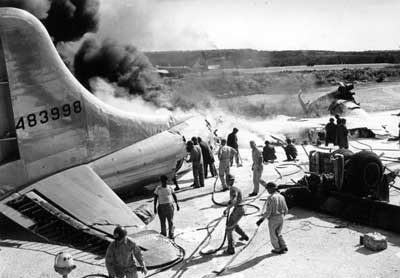



Boeing B-29 Superfortress WWII Heavy Bomber

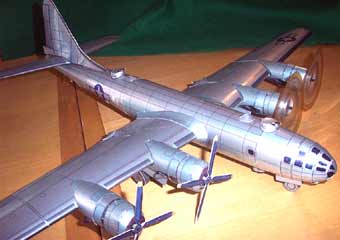 The X-1 Rocket and the "Fat Man" Atom Bomb Models carried by the B-29 are included with the B-29 Download!
The X-1 Rocket and the "Fat Man" Atom Bomb Models carried by the B-29 are included with the B-29 Download!
The Boeing B-29 was designed in 1940 as an eventual replacement for the B-17 and B-24. The first one built made its maiden flight on September 21, 1942. In December 1943 it was decided not to use the B-29 in the European Theater, thereby permitting the airplane to be sent to the Pacific area where its great range made it particularly suited for the long over-water flight required to attack the Japanese homeland from bases in China. During the last two months of 1944, B-29s began operating against Japan from the islands of Saipan, Guam and Tinian.
The B-29 had many new features, including guns that could be fired by remote control. The crew areas were pressurized and connected by a long tube over the bomb bays. The tail gunner had a separate pressurized area that could only be left during un pressurized flight. The B-29 was also the heaviest production plane because of increases in range, bomb load and defensive requirements.
By the end of the World War II, the Boeing Wichita plant had built 1,644 B-29s, nearly 65 percent of the total produced during the war.
The Commemorative Air Force (CAF) has now grounded FIFI, who used to tour --last in Wichita about 4 years ago. She was coming back in Sept 0f '01, but you-know-what grounded everything but the geese. The FIFI pilots are hopefully going to pilot, and train pilots, for DOC. Those committed to preservation pull together!
Hey chip: You folks at FG just keep trying to out-do yourselves!!! Now we modelers are going to have to build the B-36, b-17 and B-29 all in the same scale. My wife said, and I quote " You had better finish the model room in the storage shed. You're NOT hanging those three from the bedroom ceiling!" Oh well, keep up the good work! Dave (10/03)
On the B-29, All I can say is WOW! Caramba, Cowabongas! (10/03)
How VERY nice! This is one that was worth the wait! Bravo, Bravo, Bravissimo! (10/03)
Thanks Chip & Crew, for two differing but excellent aircraft in their own right - l love the 'planes from the inter war era. The B 29 will be an excellent project for any spare time over Christmas! Phil Wilkinson (10/03)
Wow! Thanks - and thanks for the Russian Tu-4 markings. Discovery-Wings channel did an episode on the Tu-4. Enola is "alone" spelled backwards. Yes, it was his mother's name, but it makes you wonder. Thanks again, John
WAAAYY TO GO CHIP & GANG! wm
Chip and Crew, Thanks again for such a wonderful creation! The way you guys are pumping out these fantastic models I will have to put on a major house extension to display these little beauties. Regards, Louis Rizzo Urbanform Designs P/
We are DEFINITELY havin' fun.. Steve B. MD
The model looks great I will start building it as you read this...Lucas Hidding Holland
Guys, Great kits, I never thought I would see a B-17 or B-29 paper kit. I do enjoy the era of wood and fabric. Have you ever considered making a Dragon Rapide, Handley Page 400, De Havilland DH-4, or the French Voison? So much paper, so little time. Thanks JW
I'm pretty excited about this model; my Dad worked on these planes and I'm going to surprise him with my rendition. Paul Berger
Hi Chip! You guys are super. I'm always eagerly awaiting whatever's next. You ought to see my office..Thanks, and best regards, Bob F
I downloaded the B-29. WOW!! So glad I put the plastic modeling to one side, who needs it when there are beauties like this to be had? Derek
The Boeing B-29 Superfortress was an American four-engine heavy bomber, and easily the largest aircraft of World War II. It was the primary US strike weapon against Japan and continued to serve long after the war was over.
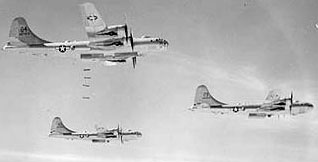
In January 1940, with the B-17 just entering service and the bigger Consolidated B-24 still more than a year away, the Air Corps issued a request for proposals for a much larger bomber, which was to have the range for operation over the Pacific - it being understood that war with Japan was all but inevitable. Four firms submitted design studies, but Douglas and Lockheed soon withdrew. In September 1940 Boeing and Consolidated were awarded development contracts for the XB-29 and the XB-32.
The Boeing B-29 was designed in 1940 as an eventual replacement for the B-17 and B-24. The first one built made its maiden flight on September 21, 1942. In December 1943 it was decided not to use the B-29 in the European Theater, thereby permitting the airplane to be sent to the Pacific area where its great range made it particularly suited for the long over-water flight required to attack the Japanese homeland from bases in China. During the last two months of 1944, B-29s began operating against Japan from the islands of Saipan, Guam and Tinian.
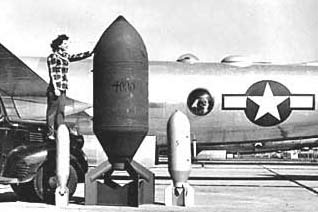 The B-29 had many new features, including guns that could be
fired by remote control. The crew areas were pressurized and connected
by a long tube over the bomb bays. The tail gunner had a separate
pressurized area that could only be left during un pressurized
flight. The B-29 was also the heaviest production plane because
of increases in range, bomb load and defensive requirements.
The B-29 had many new features, including guns that could be
fired by remote control. The crew areas were pressurized and connected
by a long tube over the bomb bays. The tail gunner had a separate
pressurized area that could only be left during un pressurized
flight. The B-29 was also the heaviest production plane because
of increases in range, bomb load and defensive requirements.
By the standards of the day, it was an enormous airplane: 30m long, a 43m wingspan, over 32 tonnes empty, and when fully loaded almost 63 tonnes. For range, the mid-set wings had a high aspect ratio, and to keep the landing speed within reason, large Fowler flaps were fitted. Three separate pressurized crew compartments were provided: one in the nose, a second one just aft of the wing for gunners, and a third, isolated one for the tail gunner. Rather than fit traditional bulky manned gun turrets, Boeing used small, remote control units (which were to give endless trouble in the early years).
The manufacturing task was immense, involving four main factories at Renton, Wichita (both Boeing plants), Marietta (Bell) and Omaha (Martin), and thousands of sub-contractors.
Boeing built a total of 2,766 B-29s at plants in Wichita, Kansas, (previously the Stearman Aircraft Co., bought by Boeing in 1929) and in Renton, Washington. The Bell Aircraft Co. built 668 of the giant bombers in Georgia, and the Glenn L. Martin Co. built 536 in Nebraska. Production ended in 1946.
Perhaps the most recognized B-29 is the "Enola Gay",
which dropped an atomic bomb on Hiroshima in 1945. The "Bockscar",
also a B-29, dropped another nuclear weapon on Nagasaki on August
9, 1945. Shortly thereafter, Japan surrendered.
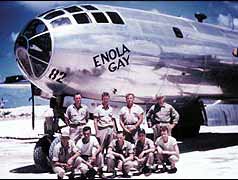
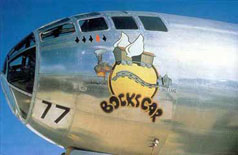
 |
 |
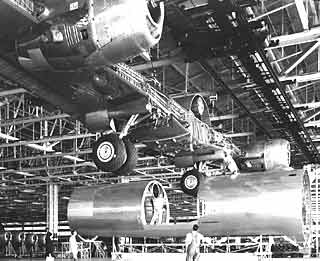 |
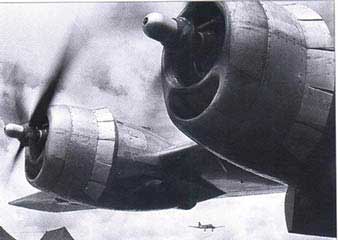 |
The Soviet Air Force's Tupolev Tu-4 was a bolt-for-bolt copy of the B-29, first widely revealed to the world audience in August of 1947.
After the war, B-29s were adapted for several functions, including in-flight refueling, anti-submarine patrol, weather reconnaissance, and rescue duty. The B-29 saw military service again in Korea between 1950 and 1953, battling new adversaries: jet fighters and electronic weapons. The last B-29 in squadron use retired from service in September 1960.
With the advent of the conflict in Korea in June 1950, the B-29
was once again thrust into battle. For the next several years
it was effectively used for attacking targets in North Korea.
The B-29 was soon made obsolete by the development of the jet engine and was replaced in the early 1950s by the Convair B-58 "Hustler", the Boeing B-47 "Stratojet", and eventually, the Boeing B-52 "Stratofortress".
As of August, 2003, the only B-29 in the world which is still airworthy is the Confederate Air Force's "Fifi." However, work is actively proceeding at the Boeing plant in Witchita, Kansas on restoring a B-29 named "Doc," and the airplane is expected to fly in 2004. Also, the United States Air Force Museum at the old Wright-Patterson Air Force base is considering restoring "Bock's Car" to airworthy condition; it is presently restored as a static display. In addition, the Smithsonian has not decided whether to restore "Enola Gay" as a static display or to bring the airplane back to flight status.
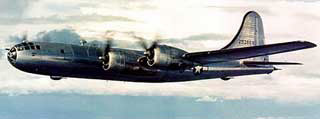 The B-29A was the version of the Superfortress built
by Boeing at the Navy-owned Renton plant. The B-29A was essentially
the same as the B-29, differing from the B-29 primarily in the
wing structure. The B-29 employed a two-piece wing center section
that was bolted together at the center line and which was installed
as a single unit passing entirely through the fuselage and supporting
the engine nacelles. The B-29A used a very short stub center section
that projected only a very short distance beyond the fuselage
sides. Each pair of engine nacelles was fitted to a separate short
section of wing. The outer wing panels attached at the same point
on B-29s and B-29As alike. This change gave the B-29A an additional
foot of wingspan as compared to the B-29.
The B-29A was the version of the Superfortress built
by Boeing at the Navy-owned Renton plant. The B-29A was essentially
the same as the B-29, differing from the B-29 primarily in the
wing structure. The B-29 employed a two-piece wing center section
that was bolted together at the center line and which was installed
as a single unit passing entirely through the fuselage and supporting
the engine nacelles. The B-29A used a very short stub center section
that projected only a very short distance beyond the fuselage
sides. Each pair of engine nacelles was fitted to a separate short
section of wing. The outer wing panels attached at the same point
on B-29s and B-29As alike. This change gave the B-29A an additional
foot of wingspan as compared to the B-29.
The B-29A was powered by four R-3350-57 engines. 1119 B-29As
were built, block numbers reaching -75. The 20-mm cannon
was removed from the tail turret beginning with production Block
20, and a pair of 0.50-inch guns were added to the top forward
turret to provide additional protection against fighter attacks
coming from the front.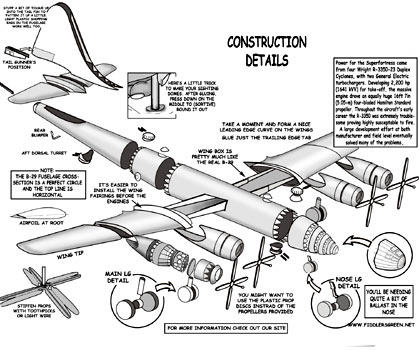
Revised engine nacelles were developed and tested and were to be used on late-model B-29As. These engine nacelles had the oil coolers and inter coolers moved further aft, which gave them a "chinless" appearance. Because of this chinless appearance, these nacelles became known by the nickname "Andy Gump", who was a famous cartoon character of the period.
Some early B-29As were fitted with pneumatically-operated bomb-bay doors which could be snapped shut in less than a second. The normal hydraulic doors took seven seconds to close. By early 1945, all B-29s were being manufactured with pneumatic doors as a standard fit.
The B-29 had always been somewhat underpowered for its weight, and in search of more power, one B-29A (42-93845) was handed over to Pratt & Whitney for conversion as a testbed for the four-row 28-cylinder Pratt & Whitney R-4360 air-cooled radial engine. This aircraft was later re designated XB-44, and was readily recognizable by the new engine installation, with the oil cooler intake pulled further back on the lower part of the nacelle. The aircraft had been initially ordered into production as the B-29D, but all contracts were cancelled at the end of the war. However, the B-29D project was later reinstated as B-50A.
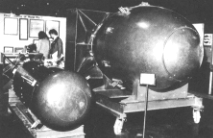 The
A-Bombs used over Japan; Little Boy (left) and Fat Man (right)
The
A-Bombs used over Japan; Little Boy (left) and Fat Man (right)
Just three days after the bomb was dropped to Hiroshima, the second atomic bomb called "Fat Man" was dropped to Nagasaki. Though the amount of energy generated by the bomb dropped to Nagasaki was significantly larger than that of the Little Boy, the damage given to the city was slighter than that given to Hiroshima due to the geographic structure of the city. It is estimated that approximately 70,000 people died by the end of the year because of the bombing.
The volunteers who participated in this project, strongly believe that the world must learn about weapons of total destruction. We hope that the information presented here will help you understand the pain and devastation that nuclear weapons can cause. We don't want you to just feel sorry for the people of Hiroshima and Nagasaki, the war inflicted untold pain and suffering on many people in Asia and the Pacific. Rather we want you to work with us to ensure that all of us can live in a safe world.
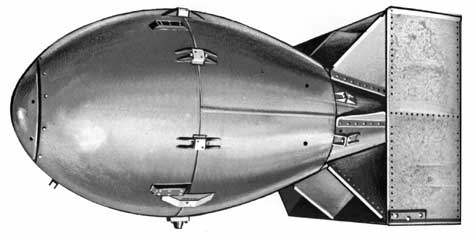
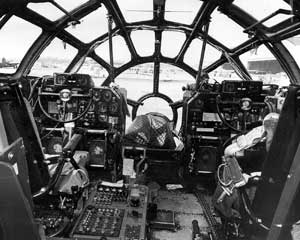 |
Cockpit of the Boeing B-29 Superfortress. |
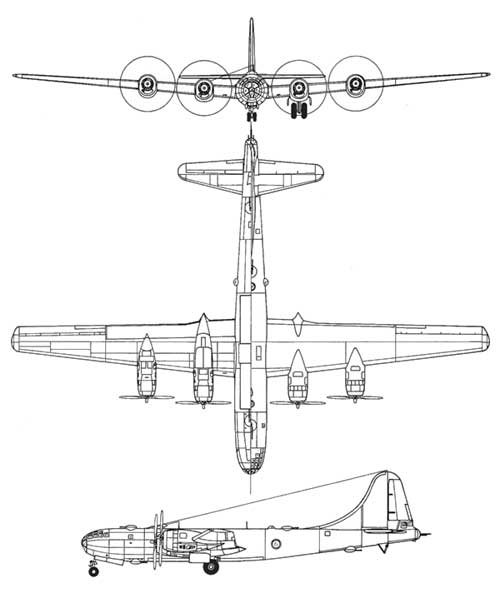
Crew: 10 |
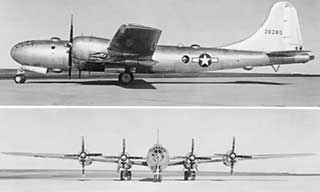 |
 |
|||
| A: The forward cabin was connected to the rear cabin by a crawlway. The gunners sat in the back, and there were bunks for resting during long missions. | B: Two enormous weapons bays carried the B-29's bombload. Each bay had winches inside to hoist the bombs up into the aircraft. | C: Under its tail, the Superfortress had a retractable tail bumper, which protected the rear fuselage when the aircraft took off. | D: Sitting alone in the tail compartment, the tail gunner had two machine guns and a 20-mm cannon at his fingertips. |
